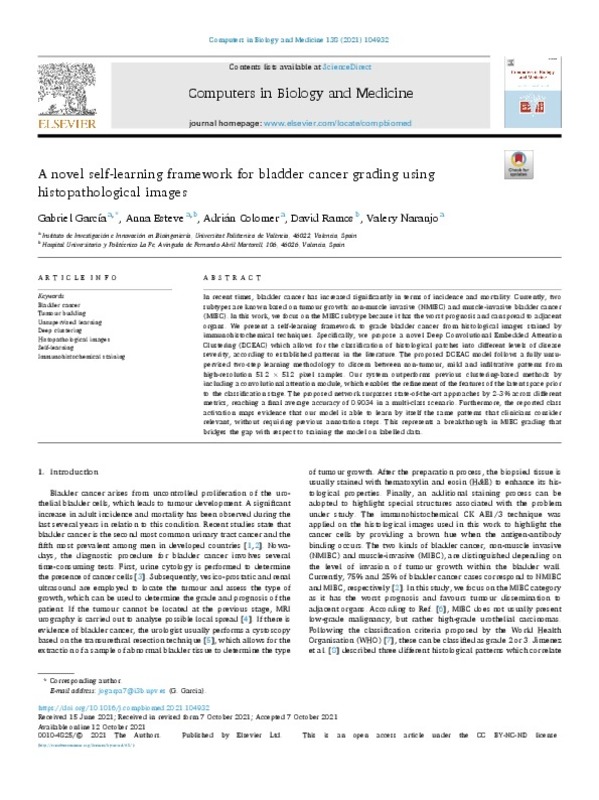JavaScript is disabled for your browser. Some features of this site may not work without it.
Buscar en RiuNet
Listar
Mi cuenta
Estadísticas
Ayuda RiuNet
Admin. UPV
A novel self-learning framework for bladder cancer grading using histopathological images
Mostrar el registro sencillo del ítem
Ficheros en el ítem
| dc.contributor.author | García-Pardo, José Gabriel
|
es_ES |
| dc.contributor.author | Esteve, Anna
|
es_ES |
| dc.contributor.author | Colomer, Adrián
|
es_ES |
| dc.contributor.author | Ramos, David
|
es_ES |
| dc.contributor.author | Naranjo Ornedo, Valeriana
|
es_ES |
| dc.date.accessioned | 2022-01-27T19:03:13Z | |
| dc.date.available | 2022-01-27T19:03:13Z | |
| dc.date.issued | 2021-11 | es_ES |
| dc.identifier.issn | 0010-4825 | es_ES |
| dc.identifier.uri | http://hdl.handle.net/10251/180289 | |
| dc.description.abstract | [EN] In recent times, bladder cancer has increased significantly in terms of incidence and mortality. Currently, two subtypes are known based on tumour growth: non-muscle invasive (NMIBC) and muscle-invasive bladder cancer (MIBC). In this work, we focus on the MIBC subtype because it has the worst prognosis and can spread to adjacent organs. We present a self-learning framework to grade bladder cancer from histological images stained by immunohistochemical techniques. Specifically, we propose a novel Deep Convolutional Embedded Attention Clustering (DCEAC) which allows for the classification of histological patches into different levels of disease severity, according to established patterns in the literature. The proposed DCEAC model follows a fully unsupervised two-step learning methodology to discern between non-tumour, mild and infiltrative patterns from high-resolution 512 x 512 pixel samples. Our system outperforms previous clustering-based methods by including a convolutional attention module, which enables the refinement of the features of the latent space prior to the classification stage. The proposed network surpasses state-of-the-art approaches by 2-3% across different metrics, reaching a final average accuracy of 0.9034 in a multi-class scenario. Furthermore, the reported class activation maps evidence that our model is able to learn by itself the same patterns that clinicians consider relevant, without requiring previous annotation steps. This represents a breakthrough in MIBC grading that bridges the gap with respect to training the model on labelled data. | es_ES |
| dc.description.sponsorship | This work has been partially funded by the European Union's Horizon 2020 research and innovation programme under the Marie Sklodowska Curie grant agreement No 860627 (CLARIFY Project), the State Research Spanish Agency under the AI4SKIN project (PID2019- 105142RB-C21) and GVA through project PROMETEO/2019/109. The work of Gabriel García has been supported by the State Research Spanish Agency PTA2017-14610-I. The equipment used for this research has been funded by the European Union within the operating Program ERDF of the Valencian Community 2014-2020 with the grant number IDIFEDER/2020/030. | es_ES |
| dc.language | Inglés | es_ES |
| dc.publisher | Elsevier | es_ES |
| dc.relation.ispartof | Computers in Biology and Medicine | es_ES |
| dc.rights | Reconocimiento - No comercial - Sin obra derivada (by-nc-nd) | es_ES |
| dc.subject | Bladder cancer | es_ES |
| dc.subject | Tumour budding | es_ES |
| dc.subject | Unsupervised learning | es_ES |
| dc.subject | Deep clustering | es_ES |
| dc.subject | Histopathological images | es_ES |
| dc.subject | Self-learning | es_ES |
| dc.subject | Immunohistochemical staining | es_ES |
| dc.subject.classification | TEORIA DE LA SEÑAL Y COMUNICACIONES | es_ES |
| dc.title | A novel self-learning framework for bladder cancer grading using histopathological images | es_ES |
| dc.type | Artículo | es_ES |
| dc.identifier.doi | 10.1016/j.compbiomed.2021.104932 | es_ES |
| dc.relation.projectID | info:eu-repo/grantAgreement/AEI/Plan Estatal de Investigación Científica y Técnica y de Innovación 2017-2020/PID2019-105142RB-C21/ES/CARACTERIZACION DE NEOPLASIAS DE CELULAS FUSIFORMES EN IMAGENES HISTOLOGICAS/ | es_ES |
| dc.relation.projectID | info:eu-repo/grantAgreement/GVA//IDIFEDER%2F2020%2F030/ | es_ES |
| dc.relation.projectID | info:eu-repo/grantAgreement/EC/H2020/860627/EU/ | es_ES |
| dc.relation.projectID | info:eu-repo/grantAgreement/GVA//PROMETEO%2F2019%2F109//COMUNICACION Y COMPUTACION INTELIGENTES Y SOCIALES/ | es_ES |
| dc.relation.projectID | info:eu-repo/grantAgreement/AEI//PTA2017-14610-I//AYUDA TECNICO DE APOYO MINISTERIO-GARCIA PARDO/ | es_ES |
| dc.relation.projectID | info:eu-repo/grantAgreement/AGENCIA ESTATAL DE INVESTIGACION//PTA2017-14610-I//AYUDA TECNICO DE APOYO MINISTERIO-GARCIA PARDO/ | es_ES |
| dc.rights.accessRights | Abierto | es_ES |
| dc.contributor.affiliation | Universitat Politècnica de València. Instituto Interuniversitario de Investigación en Bioingeniería y Tecnología Orientada al Ser Humano - Institut Interuniversitari d'Investigació en Bioenginyeria i Tecnologia Orientada a l'Ésser Humà | es_ES |
| dc.contributor.affiliation | Universitat Politècnica de València. Departamento de Comunicaciones - Departament de Comunicacions | es_ES |
| dc.description.bibliographicCitation | García-Pardo, JG.; Esteve, A.; Colomer, A.; Ramos, D.; Naranjo Ornedo, V. (2021). A novel self-learning framework for bladder cancer grading using histopathological images. Computers in Biology and Medicine. 138:1-11. https://doi.org/10.1016/j.compbiomed.2021.104932 | es_ES |
| dc.description.accrualMethod | S | es_ES |
| dc.relation.publisherversion | https://doi.org/10.1016/j.compbiomed.2021.104932 | es_ES |
| dc.description.upvformatpinicio | 1 | es_ES |
| dc.description.upvformatpfin | 11 | es_ES |
| dc.type.version | info:eu-repo/semantics/publishedVersion | es_ES |
| dc.description.volume | 138 | es_ES |
| dc.identifier.pmid | 34673472 | es_ES |
| dc.relation.pasarela | S\447664 | es_ES |
| dc.contributor.funder | Generalitat Valenciana | es_ES |
| dc.contributor.funder | AGENCIA ESTATAL DE INVESTIGACION | es_ES |
| dc.contributor.funder | Agencia Estatal de Investigación | es_ES |
| dc.contributor.funder | European Regional Development Fund | es_ES |
| dc.contributor.funder | COMISION DE LAS COMUNIDADES EUROPEA | es_ES |








